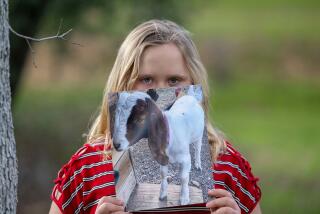Time to End Kids’ Ironic 4-H Projects
- Share via
Four sheep owned by an Ojai family recently were attacked by a pair of large dogs. Sadly, three of the sheep died and last week one of the dogs was put to death as well.
No one would argue that this tragedy was indeed a horrifying experience for the teenager and her family, as well as for the animals involved.
One of the sheep, named Moe, had been raised from a small black-faced lamb with much love and care by the youth as part of a local 4-H program. Moe was destined to be sold at the Ventura County Fair 4-H market animal auction this week and from there would have gone to the slaughterhouse.
Moe’s short life ended four weeks sooner than planned.
It is accepted that the 4-H market animal auctions at the fairgrounds are an exciting experience for the youngsters who own and raise these animals.
The high prices the youngsters receive as a result of family members and friends bidding on their animal are unrealistic compared to what ranchers in the business of raising livestock can expect.
4-H market animal projects are outdated and no longer have validity in today’s society.
Raising meat for human consumption is a luxury when one considers the expense of the natural resources needed to produce a meat diet.
The plants and grains produced to feed market animals require land, water and labor. These plants and grains would be better used to feed humans instead of animals eaten by humans. A great loss of energy occurs at each link in the food chain, not to mention the health problems related to a meat diet.
Don’t we want to promote compassion and sensitivity and respect for all living creatures in our children? These animals have developed a loving, trusting relationship with the young people who raise and care for them.
Why would we want to desensitize our children by encouraging them to believe that it’s OK to put a price on an animal’s life and trade that life for a large paycheck at auction? Surely turning them over for slaughter is the ultimate betrayal.
Everyone agrees that these market animals are very well cared for by the 4-H youngsters. Animals accepted for auction are in good condition. However, the good care and responsibility are not generally a long-term commitment--in most cases less than a year.
Inhumane procedures endured by these market animals (castration without anesthesia, tail docking, dehorning, etc.,) are forgotten and not discussed.
Going to slaughter is not a picnic. The terror experienced by animals transported to the slaughterhouse in hot, overcrowded trucks and the actual slaughtering process would have been no less terrifying for Moe than being killed by dogs.
Although the federal Humane Slaughter Act is intended to provide a humane end to a market animal’s life, it seldom happens that way.
According to the recently published book “Slaughterhouse” by Gail A. Eisnitz, chief investigator for the Humane Farming Assn., adequate inspection and control of slaughterhouses in the United States does not exist.
The responsibility of caring for 4-H animals should not end with their sale at the Ventura County Fair auction. At the very least, 4-H leaders should do a thorough investigation of how these much-loved animals are transported to the slaughterhouse and the manner in which they are killed.
As caring and compassionate human beings it is not enough to express our concern over the killing of sheep by two loose dogs. We should be equally concerned over the fate that would have awaited Moe had he lived four weeks longer.
More to Read
Sign up for Essential California
The most important California stories and recommendations in your inbox every morning.
You may occasionally receive promotional content from the Los Angeles Times.













